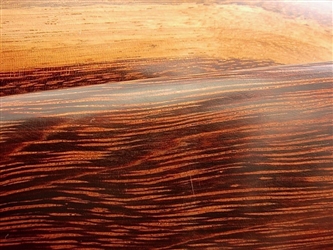 |
Tamarind (aka Tetul, aka Indian Rosewood)
Originally native to East Africa and Madagascar, and now widely planted throughout tropical regions worldwide, Tamarind is a very durable exotic hardwood that delivers a powerful resonant tone similar to rosewood.
Grown extensively in India, Tamarind is best known for its edible fruit. The word tamarind literally means "date of India."
Bone Rattling Facts
Tamarind offers excellent acoustical properties for musical instruments.
Because the heartwood is hard to very hard, fibrous, heavy and strong, and regarded as very durable, Tamarind is especially well suited for hand-held musical instruments.
Tamarind is an alternative to rosewood. But like ebony, Tamarind is a tough wood that is hard to work. Being so tough, the wood is highly prized for furniture, panelling, wheels, axles, gears for mills, industrial presses, ploughs, mallets, knife and tool handles, rice pounders, mortars and pestles—and now, musical rhythm bones!
Cool Facts
-
The tree's tamarind fruit fetches a better price in the marketplace than its timber.
- Tamarind wood burns well as fuel and makes a high-grade charcoal (although you might not want to brag about this to your musician friends).
- In addition to excellent charcoal, Tamarind is valued for making gunpowder—and was used as a major fuel that powered Indian cars and trucks during World War II.
- Tamarind is an essential ingredient for chutneys, curries—and Worcestershire Sauce.
- Tamarind pulp is a key ingredient in flavoring curries and rice in south Indian cuisine, as well as in the Chigali lollipop.
- Tamarind has been found to lower cholesterol in hen serum and in the yolks of the eggs they laid.
Figures below are approximate (but pretty darn close)
Tonality
Can't Decide Which Bones to Choose?
Check out this handy guide: Bone FAQs
Scroll down for technical Padauk facts...
|
|
Tamarind Facts
Scientific Name
Tamarindus indica
Other Names
Tamarind is known by more than 75 common names.
Ajagbo
Ajagbon
Ambli
Amli
Amlika
Asam
Camalindo
Chicha
Chinch
Chinta
Chita
Chitz
Chwaa
Darachi
Hitta
Hunase
Icheku
Imili
Imli
Indian date
Iti
Jatami
Jojo
Jojo's
Kalamendo
Kamal
Kamalindo
Karangi
Keditia
Khenthiri
Kopu
Koya
Magyeng
Magyi
Mkwadju
Mkwaju
Msisa
Msisi
Mukoge
Munondo
Museka
Musika
Muthithi
Muthumura
Mzumusa
Neddi
Ol-masamburai
Puli
Samia
Shenta
Sitta
Siyembela
Taman
Tamarese
Tamarin
Tamarind
Tamarind tree
Tamarindade
Tamarinde
Tamarindier
Tamarindo
Tamarinier
Tamsugu
Tentul
Tentuli
Tenturi
Tetar
Teteli
Tetui
Tetuli
Tintil
Tintiri
Tintul
Tintuli
Titri
Tsamia
Tsamiya
Udeguegor
Lookalike Woods
Rosewood
Grain
The grain is typically straight, but can be irregular or mottled with interlocking waves.
Texture
The figured texture varies from fine to coarse with closed pores.
Luster
Luster has been described as high.
Heartwood Color
Brown & black sometimes creamy sapwood
(barbecued ribs)
Brown & black sometimes creamy sapwood (barbecued ribs)
The heartwood is usually a dark or reddish brown sometimes with purple and yellow to golden-yellow to orange streaks often mottled with black and brown.
Sapwood Color
Varies from white to yellow. The sapwood is very wide and sharply demarcated from the heartwood. Spalting and other discoloration is common.
Aroma
No specific smell or taste.
Toxicity
Unspecified reports of toxicity have been reported for this wood species. Tamarind fruit has no known reported cases of allergic or toxicity.
Woodworking
Befause the wood is hard to work, Tamarind has been compared to ebony. The high density and interlocked grain make it difficult to work with hand tools or machinery.
Environmental Profile
Status has not been officially assessed.
Distribution
The tree is native to East Africa and Madagascar. Tamarind is a naturalized species throughout the West Indies and from Mexico to Brazil. It is also cultivated in southern Florida and Bermuda. It is planted as an ornament in Puerto Rico. It is cultivated throughout India, found by roadsides, and frequently in the wild. Also common in the drier parts of Burma. It occurs in the savannah forests throughout tropical Africa and is also often planted as a shade and ornamental tree because of its evergreen foliage and dense crown.
Tree Data
The tree grows from 50 to 80 feet (15 to 24 m) tall with a trunk diameter from 2 to 3 feet (.6 to 1 m).
|
|
|